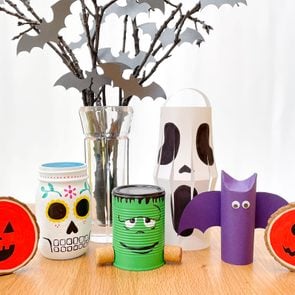What’s Really in Canned Pumpkin, Anyway?
Updated: Aug. 18, 2022

Canned pumpkin is coming under fire for its "100% pure pumpkin" claims. Find out what's really in the pumpkin puree in your pantry.
As Halloween approaches, there’s nothing like pumpkin, the ultimate fall flavor, to get you in the spooky, autumnal spirit. Chances are, you’ve been checking out pumpkin carving ideas (and pumpkin carving templates) and stocking up on pumpkin puree, the canned pumpkin that goes deliciously into pumpkin pie, pumpkin soup, pumpkin coffee creamer, pumpkin ravioli—you name it. But have you ever wondered … is canned pumpkin really pumpkin?
When it comes to food facts, this one’s quite a hot topic. Some angry chefs and foodies have been complaining that canned pumpkin is false advertising—that the puree inside is actually a different squash. So, what’s the truth? Let’s get into it.
Is canned pumpkin really pumpkin?
The FDA is pretty loose about the foods it allows to be marketed as “pumpkin.” The agency will allow companies to call their purees “pumpkin” as long as it’s a mix of Cucurbita pepo (field pumpkins) or its close cousins Cucurbita maxima (sweet squashes such as acorn, kabocha and Hubbard). Some distributors will even mix pumpkin and squash to get the right consistency.
Case in point: Libby’s, which produces 85% of the world’s canned pumpkin, has come under fire for cultivating its own type of squash. Some argue the company is misleading buyers by bragging that it sells “100% pure” pumpkin when it doesn’t actually use the pie pumpkins or carving pumpkins you’d find in stores. The thing is, it isn’t that simple.
Botanically and legally speaking, there’s no real difference between a pumpkin and a squash. It really just comes down to what sounds appetizing. “If I eat it with dinner, it’s squash. If it’s for dessert, it’s a pumpkin,” says John Ackerman, owner of Libby’s supplier, Ackerman Family Farm. As for the “squash” Libby’s uses, it’s a variety of Dickinson pumpkin. Yes, pumpkin.
Do these pumpkins differ from regular pumpkins?
Admittedly, the Dickinsons that Libby’s uses aren’t as pretty as your typical pumpkin. Their skin is tan or beige, and their shape is more oblong than the round ones we hunt down for jack-o’-lanterns. They might look like ugly pumpkins, but they look like pumpkins nonetheless. “It’s lightly ribbed and has a stem on it,” says Ackerman. “Looking at that Dickinson pumpkin, you would call it a pumpkin.”
Libby’s isn’t hiding what’s in their cans at all. They even have a full informational video showing off their pumpkins. FYI, these pumpkins have been cultivated to have a less stringy texture than the original Dickinsons they came from, but that doesn’t change the fact that they’re still pumpkins. Instead of using high-tech GMOs, says Ackerman, plant breeders hand-pollinate Dickinson pumpkins to get the best flavor—sort of like how the carving pumpkins in your patch have been cultivated for their shape.
The bottom line?
Instead of stressing about whether the squash in your puree would have made a nice jack-o’-lantern, you might as well just enjoy your pie. Or your Costco pumpkin pie (which goes great with ice cream, might we add).
Now that you know whether canned pumpkin is really pumpkin, it’s time to tackle other food mysteries. For example, do you know what are marshmallows made of? Or where vanilla flavoring comes from? You will soon!
Sources:
- FDA: “CPG Sec 585.725 “Pumpkin” – Labeling Articles Made from Certain Varieties of Squash”
- EOL: Field Pumpkin, Cucurbita pepo L.
- EOL: Buttercup Squash, Cucurbita maxima Duchesne
- Libby’s
- Morton, Illinois: “Tourism & Visitor Information”
- John Ackerman, owner of Libby’s supplier, Ackerman Family Farm






















